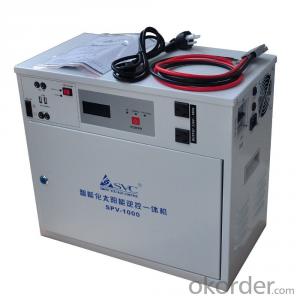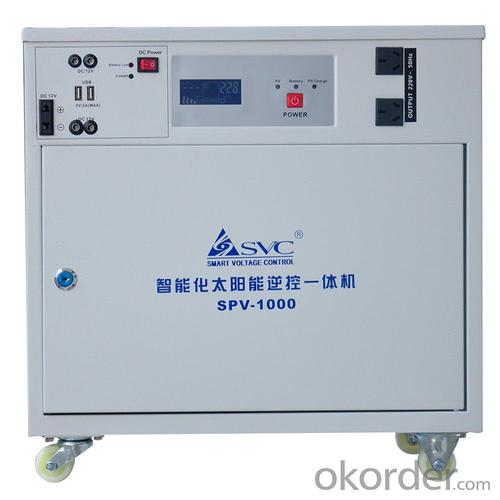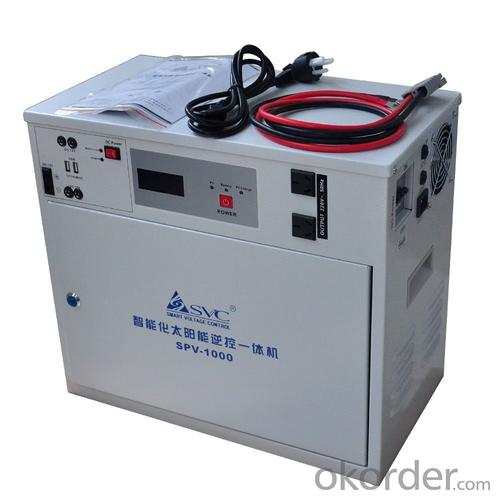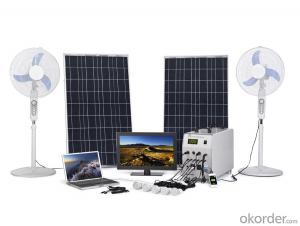Sun Solar Energy Systems - Pure Sine Wave LCD/LED AC/DC 360W Solar Power System
- Loading Port:
- China main port
- Payment Terms:
- TT OR LC
- Min Order Qty:
- 20 carton
- Supply Capability:
- 10000 carton/month
OKorder Service Pledge
OKorder Financial Service
You Might Also Like
ALL-IN-ONE 360W Pure Sine Wave AC/DC Output LCD/LED 12V/24V Solar Power System

| Model | SPV-600 | SPV-800 | SPV-1000 | SPV-1500 | |
| Rated power: | 360W | 480W | 600W | 1000W | |
| storage battery: | 12V(optional:24V) | ||||
| specifications of charging | |||||
| charging mode | PV charging and mains charging | ||||
| PWM solar controller: | voltage | 12V(optional:24V) | |||
| current | 30a(Max)(depends on the power of solar panels) | ||||
| PV maximm voltage | 12V system(potional:24V system) | ||||
| 25V | |||||
| hybrid charging | PV charging current:when I>15A,AC charging current is off | ||||
| PV charging current:when I>15A,AC charging current is 5A | |||||
| PV charging current:when I≤15A,AC charging current is 10A | |||||
| DC output system | |||||
| Charging port /USB | 5V/2A(Total)/ 2 units | ||||
| output port of DC | 12V/1.5A/ 3 units | ||||
| AC Mode | |||||
| Input voltage | 145-275VAC | ||||
| Input frequency | 48-54Hz(50HZ),Same s AC | ||||
| Output voltage | 200-240VAC | ||||
| Short Circuit | Breaker | ||||
| Inverter Mode | |||||
| Output voltage | 220VAC±5% | ||||
| Output frequency | 50±1% Hz(Auto detection) | ||||
| Output P.F | ≥0.6 | ||||
| Output wave form | Pure Sine Wave | ||||
| Transfer time | Typical 2-6ms,10ms max | ||||
| Overload capability | 110% Shut down within 60sec. | ||||
| 120% Shut down within 5sec. | |||||
| Short Circuit | ≥20ms System shut down automatically | ||||
| priority principle of mains and inversion | intelligent and automatic recongnition | ||||
| protection | protectings of output overload,output short circuit,inpot over voltage,input under voltage and over-temperature | ||||
| specifications of the overall unit | |||||
| dimension(mm) | 455*250*400 | ||||
| Net weight(KG) | 11 | 12 | 14 | 16 | |
| Gross weight(KG) | 12.5 | 13.5 | 16 | 18.5 | |
| display | display mode | LCD+LED | |||
| display information | LCD:working and protection status of inerter,charging status of storage battery | ||||
| LED:indications of working status and PV charging | |||||
| ENVIRONMENT | |||||
| ENVIRONMENT | indoor,or outdoor with waterproof measures | ||||
| Environment of performance: | Temperature 0℃~40℃,Humidity 20%~90%,non condensing | ||||
| Noise Level | Less than 40dB(lm) | ||||


1. Wide range of input voltage
The UPS can offer normal and stable service voltage under its input voltage range. When the input voltage is out of its range the machine will switch to battery mode automatically to keep the output power in order to protect the equipment, such as computers, ensure they will not be damaged by the over high or over low voltage, users can continue the operation of equipment for a while or save the data on computers while the power network is abnormal.
2. Wide range of AVR(Automatic voltage regulation)
In the product’s input voltage range and under 3 steps of intelligent AVR function, it can provide a stable output voltage.
3. Automatic self detection when UPS on(LED).
Before the UPS on, red, yellow, blue LED will light up two times by cycle turns, after self detection UPS switch to AC mode/battery mode or working mode.
4. Silence function
In the "battery mode", shortly press the switch to turn off the buzzer. But the battery is about to run out or the load is too heavy, the buzzer sound cannot be muted.
5. Overload protection
In the battery mode, output voltage turn down correspondingly when it is overload, after the capacity of load is lower than the rated power then output voltage will back to rated value, it ensures the UPS will not shut down by abrupt overload which caused by surging current during the computer is working and other equipment is added.
6. Short circuit protection
When the mis-operation caused the load short circuit or computer failure (such as power tube breakdown of switch) cause short circuit, the UPS will shutdown automatically for protection.
7. The low current switch
This UPS adopts low current switch to extend the service life which is longer than conventional battery and high current switch in AC current path.
8. Automatic charging
There are two charging mode, charging time is faster than ordinary charging mode, higher efficiency, and greatly prolonging the service life of the battery.
9. With a bypass output
Independent bypass output socket for external printers or scanners of computer peripherals, with surge protection of the load.
- Q:Can solar energy systems be used in powering theme parks or water parks?
- Yes, solar energy systems can definitely be used to power theme parks or water parks. Solar energy is a clean and renewable source of power that can provide a sustainable and cost-effective solution for meeting the energy needs of these establishments. Theme parks and water parks require a significant amount of electricity to operate attractions, lighting, water pumps, and other facilities. Installing solar panels can help reduce their reliance on conventional energy sources and decrease their carbon footprint. The large open spaces available in theme parks and water parks are ideal for installing solar panels, which can be mounted on rooftops, carports, or ground-mounted arrays. Solar energy systems can generate electricity by converting sunlight into usable energy through photovoltaic (PV) panels. These panels can be integrated into the infrastructure of the park discreetly and efficiently. The energy generated during the day can be used immediately to power rides, lighting, and other equipment, and any excess energy can be stored in batteries for use during periods of low sunlight or at night. Furthermore, solar energy systems can provide a reliable source of power and reduce the vulnerability of theme parks and water parks to power outages or disruptions in the grid. This is particularly important in areas prone to extreme weather events. By incorporating backup battery storage systems, solar energy can provide a constant and uninterrupted power supply even during emergencies. In addition to the environmental and reliability benefits, solar energy systems can also provide long-term cost savings for theme parks and water parks. While the initial installation cost might be higher, the operational costs are significantly reduced as the sun provides free and abundant energy. Over time, the savings on electricity bills can offset the initial investment, resulting in substantial cost savings for the park's owners. Overall, solar energy systems have the potential to revolutionize the power supply of theme parks and water parks. By harnessing the sun's energy, these establishments can not only reduce their environmental impact but also achieve long-term cost savings and enhanced energy reliability.
- Q:Can solar energy systems be used for space heating?
- Yes, solar energy systems can be used for space heating. Solar thermal systems can be designed to capture and convert sunlight into heat energy, which can then be used to warm indoor spaces. This can be achieved through the use of solar collectors and heat transfer mechanisms, making solar energy a viable option for space heating purposes.
- Q:What is the average payback period for a solar energy system?
- The average payback period for a solar energy system varies depending on various factors such as the system's size, location, installation costs, energy usage, and available incentives. However, on average, a residential solar energy system can pay for itself within 6 to 10 years, while commercial systems may have a payback period of 4 to 8 years. It's important to note that with advancements in technology and decreasing installation costs, the payback period for solar systems is continually decreasing, making it a more financially viable option for many.
- Q:Can solar energy systems be used for powering electronic devices?
- Yes, solar energy systems can be used for powering electronic devices. Solar panels convert sunlight into electricity, which can then be stored in batteries or used directly to power various electronic devices such as smartphones, laptops, and even larger appliances like refrigerators or air conditioning units. This renewable energy source is increasingly being utilized to reduce reliance on traditional power grids and promote sustainability.
- Q:How do solar energy systems impact the electricity transmission infrastructure?
- Solar energy systems can have a significant impact on the electricity transmission infrastructure by reducing the demand for conventional power generation and decreasing the need for transmission and distribution infrastructure investments. Additionally, solar energy systems can enhance grid resilience, as distributed generation can continue to supply electricity during disruptions or outages. However, the intermittent nature of solar power can also pose challenges to grid stability and require grid upgrades to accommodate the integration of large-scale solar installations.
- Q:How do solar energy systems affect air pollution?
- Solar energy systems have a positive impact on air pollution as they generate clean and renewable energy without emitting harmful pollutants or greenhouse gases. By reducing the reliance on fossil fuels for electricity generation, solar energy helps to improve air quality and mitigate the negative health and environmental effects associated with air pollution.
- Q:How do solar energy systems impact wildlife?
- Solar energy systems can have both positive and negative impacts on wildlife. On the positive side, solar energy reduces the overall carbon footprint and mitigates climate change, which is beneficial for many species. Additionally, solar farms can provide new habitats for certain wildlife species, such as pollinators and birds. However, solar panels can also have negative effects, such as habitat fragmentation and displacement of some species. Proper planning, design, and mitigation measures can help minimize these impacts and ensure that solar energy systems are wildlife-friendly.
- Q:How does shading affect the performance of solar panels?
- Shading negatively affects the performance of solar panels as it obstructs the amount of sunlight reaching the panels, reducing their efficiency in converting sunlight into electricity. Even a small amount of shading can significantly reduce the overall power output of a solar panel or even render it completely inactive. Therefore, it is crucial to ensure that solar panels are installed in areas with minimal shading to maximize their performance.
- Q:How long does it take to install a solar energy system?
- The time it takes to install a solar energy system can vary depending on various factors such as the size of the system, the complexity of the installation, and the availability of resources. However, on average, a typical residential solar energy system can be installed within a few days to a few weeks.
- Q:What is the impact of temperature on the performance of solar panels?
- Solar panel performance is primarily negatively impacted by temperature, although there are factors that can lessen these effects. Generally, as temperature rises, solar panel efficiency decreases. This is due to the semiconductors in the panels becoming less effective at converting sunlight into electricity as they heat up. One of the main reasons for this efficiency decrease is the correlation between temperature and solar panel voltage output. As temperature increases, voltage output decreases, resulting in a reduction in power output. This phenomenon is referred to as the solar panel's temperature coefficient, which varies depending on the panel's type and quality. Moreover, increased temperature can cause thermal expansion and contraction, placing stress on the electrical connections and components within the panel. This can lead to the panel's performance degradation over time. Nevertheless, it is important to note that not all aspects of solar panel performance are negatively impacted by temperature. In fact, higher temperatures can enhance the conductivity of the electrical connections, potentially improving the panel's overall performance. Additionally, some panels are designed with cooling mechanisms, such as air or water circulation, to maintain their temperature and mitigate the negative effects. In conclusion, temperature predominantly has a negative impact on solar panel performance, resulting in reduced efficiency and power output. However, with appropriate design and cooling mechanisms, these effects can be mitigated to some extent, enabling solar panels to continue generating electricity even in high-temperature environments.
1. Manufacturer Overview |
|
|---|---|
| Location | |
| Year Established | |
| Annual Output Value | |
| Main Markets | |
| Company Certifications | |
2. Manufacturer Certificates |
|
|---|---|
| a) Certification Name | |
| Range | |
| Reference | |
| Validity Period | |
3. Manufacturer Capability |
|
|---|---|
| a)Trade Capacity | |
| Nearest Port | |
| Export Percentage | |
| No.of Employees in Trade Department | |
| Language Spoken: | |
| b)Factory Information | |
| Factory Size: | |
| No. of Production Lines | |
| Contract Manufacturing | |
| Product Price Range | |
Send your message to us
Sun Solar Energy Systems - Pure Sine Wave LCD/LED AC/DC 360W Solar Power System
- Loading Port:
- China main port
- Payment Terms:
- TT OR LC
- Min Order Qty:
- 20 carton
- Supply Capability:
- 10000 carton/month
Offcanvas right
OKorder Service Pledge
OKorder Financial Service
Similar products
New products
Hot products
Hot Searches
Related keywords


































